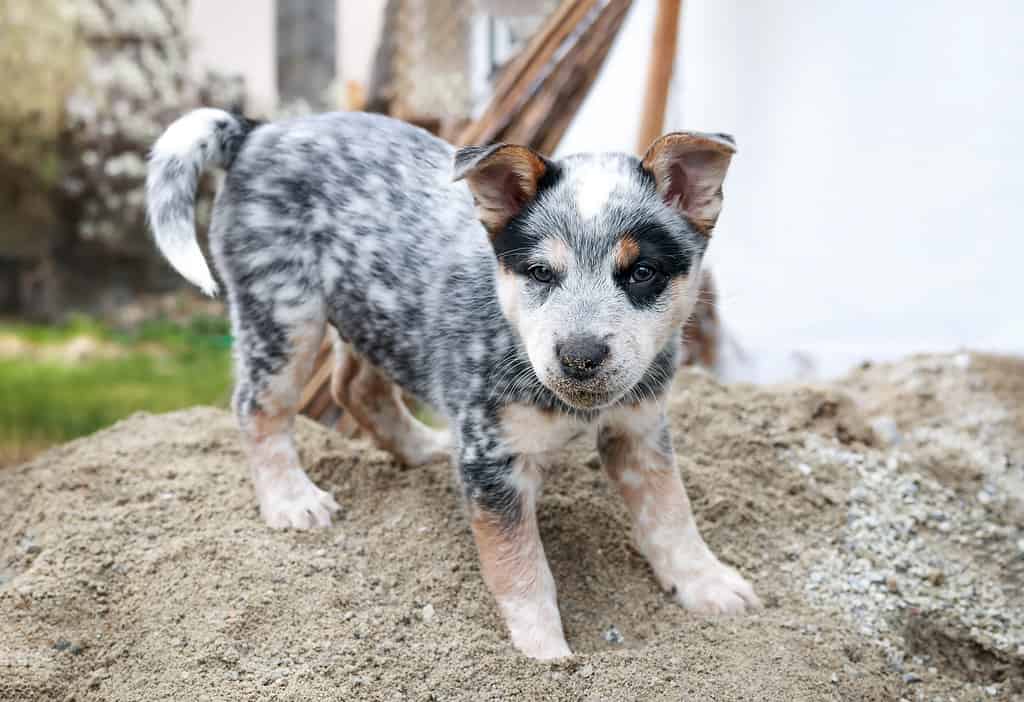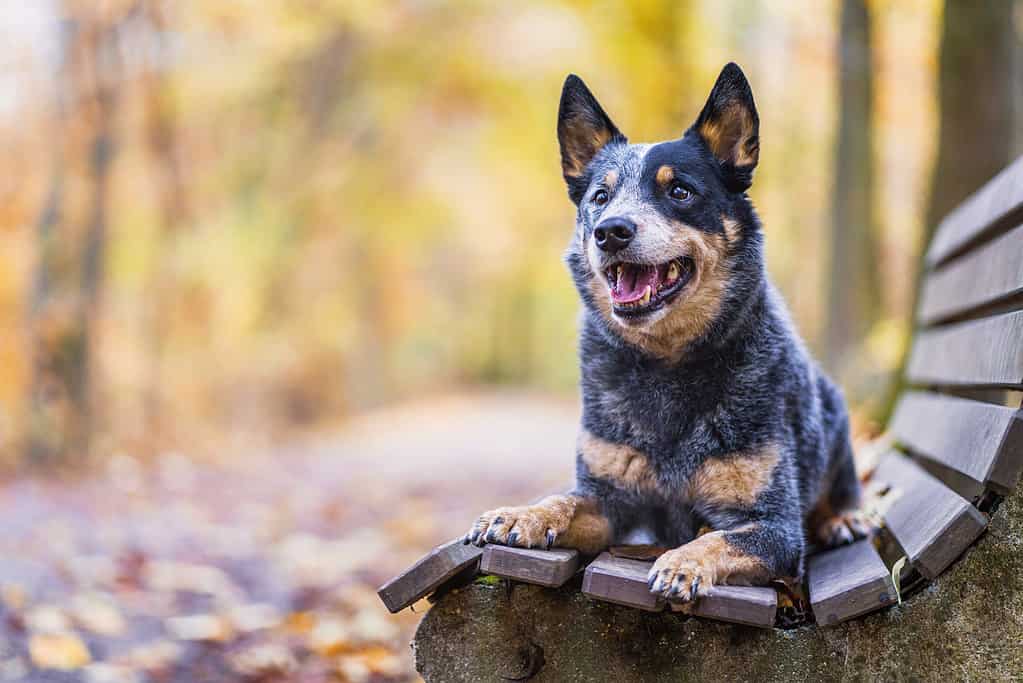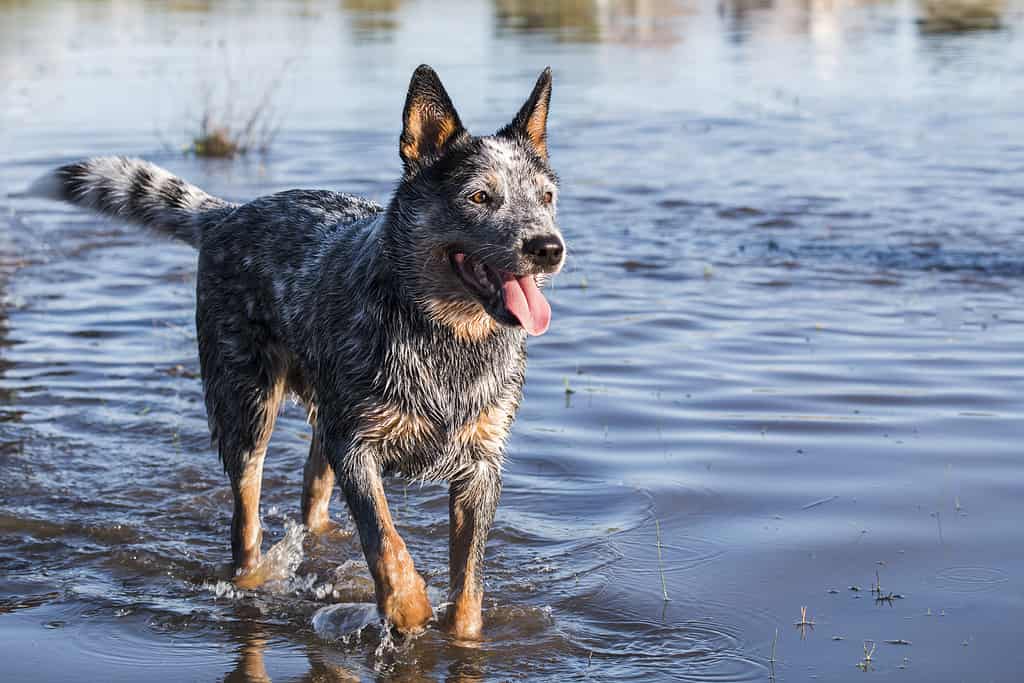Australian Cattle Dog Summary
Australian cattle dogs are renowned for their herding abilities. They originally came from Australia, where they were bred to herd cattle over long distances. They’re specifically known for their strong work ethic, intelligence, and agility. This breed also has a very distinctive coat with speckled markings. Thanks to their strong work drive, Australian cattle dogs can be exceptional working dogs.
Australian Cattle Dog Growth and Weight Chart by Age
Below is a growth chart for the average Australian cattle dog. However, it’s important to realize that this is an average. Dogs grow at very different rates.
| Age (Months) | Male Weight | Female Weight |
|---|---|---|
| Birth | 1 – 2 lbs | 1 – 2 lbs |
| 1 Month | 3 – 5 lbs | 3 – 5 lbs |
| 2 Months | 5 – 11 lbs | 5 – 11 lbs |
| 3 Months | 10 – 15 lbs | 10 – 15 lbs |
| 4 Months | 15 – 19 lbs | 15 – 19 lbs |
| 5 Months | 20 – 25 lbs | 20 – 25 lbs |
| 6 Months | 23 – 27 lbs | 23 – 27 lbs |
| 7 Months | 24 – 29 lbs | 24 – 29 lbs |
| 8 Months | 26 – 31 lbs | 26 – 31 lbs |
| 9 Months | 27 – 33 lbs | 27 – 33 lbs |
| 10 Months | 28 – 35 lbs | 28 – 35 lbs |
| 11 Months | 29 – 37 lbs | 29 – 37 lbs |
| 12 Months | 30 – 45 lbs | 30 – 45 lbs |
| 2 Years | 35 – 50 lbs | 35 – 50 lbs |
When Will My Australian Cattle Dog Stop Growing?
Australian cattle dogs typically stop growing in height and length around 12 to 18 months. However, their muscle condition will continue to develop for several months after that, so they will often continue to gain weight, though they likely won’t get taller.
It’s important to feed them correctly, providing a balanced diet based on their activity level and age. Puppies must consume a puppy formula to help ensure that they get the nutrients they need to grow.
An adult Australian cattle dog might require 1.5 to 2.5 cups of high-quality dry dog food per day. Some dogs may need more; some may need less. You can switch your dog to an adult formula whenever it stops growing.
Always follow the feeding guidelines on the back of the dog food container. However, feel free and adjust it based on the dog’s weight gain or loss.
How Big Will My Australian Cattle Dog Be When It’s Fully Grown?
Australian cattle dogs usually reach a height of 17 to 20 inches at the shoulder. They weigh between 35 to 50 pounds when fully grown. However, individual dogs can vary widely. Genetics, diet, and other factors may influence their final size.
When Should My Australian Cattle Dog Be Spayed or Neutered?
Like many other breeds, the recommended age for spaying or neutering an Australian cattle dog is typically between 6 to 9 months of age. This age ensures that the dog will not accidentally get pregnant (or get another dog pregnant). Spaying or neutering before the dog matures can help prevent certain cancers and other conditions.
However, some health issues (like hip dysplasia) can be caused by spaying or neutering too early, as it can affect their hormone levels.
Sometimes, waiting until your dog’s first heat may be best.
It’s important to ask your vet about what is best for your dog, specifically. It may depend on their overall health, for instance.
(Remember, if you purchase your dog from a breeder, you’re often required to spay or neuter them at a certain point as per the adoption contract.)
When Should My Australian Cattle Dog Be House Broken?
Australian cattle dogs should start a housebreaking routine at an early age. Preferably you should start them as early as possible, preferably as soon as you bring them home.
If you don’t start potty training right away, your dog will develop bad habits that will be harder to break later. Establish a routine immediately, taking them outside every couple of hours (more is better). Consistency in timing can help them potty train effectively.
Use positive reinforcement to encourage your dog to use the bathroom outside. Be attentive to their behavior, as well. You want to take them out immediately to avoid accidents as much as possible.
Be patient and understand that accidents are part of the process. It can take several months for your dog to be potty trained completely.
When Should My Australian Cattle Dog Stop Eating Puppy Food?
You can transition your dog from a puppy food formula to an adult formula as soon as they’re done growing, usually around 13 to 18 months. It’s better to continue the food for longer than your dog needs than for not long enough.
Switching too early can lead to nutritional deficiencies, growth problems, and health issues later.
We highly recommend choosing a quality adult food recipe. While nutrition is less important for adults than it is for puppies.
When Will My Australian Cattle Dog Start Losing Teeth?
Like most breeds, Australian cattle dogs lose their baby teeth at 4 to 6 months. This process usually causes some amount of discomfort. Therefore, your dog may also increase their chewing frequency during this time.
You should provide puppy-sage chewing toys during this time. Provide several options and encourage your dog to use them. Discourage chewing on furniture and unsafe items. However, understand that dogs need to chew during this time, so don’t expect them not to do it at all.
Start brushing your dog’s teeth during this time, too. Their permanent teeth need to be cleaned regularly to prevent dental issues later in life.
When Should I Start Training My Australian Cattle Dog?
You should start training your Australian cattle dog when you bring your puppy home. Many dog breeders will start training their puppies before sending them to their new homes. It’s important to socialize your dog from an early age, too. This prevents them from being unnecessarily aggressive later on.
Begin with basic obedience commands like “sit” and “stay.” Positive reinforcement techniques work best, as they do for most dogs. Using treats and praise works exceptionally well.
Always socialize your puppy with other animals and people whenever possible. This helps them get used to being in a range of different situations.
You should also crate-train your dog from an early age. This helps your canine learn to be alone and helps prevent separation anxiety.
We highly recommend enrolling in puppy classes from an early age. These classes help train your new puppy in fundamental commands, as well as socialize them with other puppies and people in a safe environment.
What Cues Should I Teach My Australian Cattle Dog First?
The first command you should teach your dog is to “sit.” This command is necessary for several other commands, so we recommend doing it first. After that, you can move on to other important commands, like “lay down,” “stay,” and “come.”
You should work through these commands slowly, building on your dog’s current knowledge to improve their ability to learn. Teach “leave it” along with these commands, as this helps your canine avoid eating things they shouldn’t. However, this is also challenging, so your dog will probably need to practice it for a long time.
You’ll also need to teach your dog how to “heel,” which will help them walk well on a leash.
When Will My Australian Cattle Dog Calm Down?
Australian cattle dogs tend to calm down between the ages of 1 and 2, which is typically when they stop growing. However, this depends on the dog’s personality and traits. These working dogs don’t tend to “calm down” as much as other canines.
For instance, they will always need significant amounts of exercise and mental stimulation. Their high energy levels can be too much to handle if you aren’t energetic. Consistent training is also important, as your dog may need direct instruction to behave properly at certain times.
Don’t assume your dog will “grow out of” bad behaviors.
Socialization is essential, too. A dog not properly socialized may be unnecessarily excited about nearly everything. Meeting new people and animals should be considered “normal.”
Common Health Issues Your Australian Cattle Dog Might Experience
Australian cattle dogs are prone to a few different health problems. While they are generally healthy, they can experience significant issues as they age. Poor breeding can worsen many of these problems, as most have a genetic link.
- Hip Dysplasia: This condition occurs when the hip joint doesn’t form properly while the dog is growing. Because of this, the hip joint wears unevenly, and eventually, arthritis symptoms develop. This isn’t curable, but it can be managed with medication and sometimes surgery.
- Elbow Dysplasia: This condition is extremely similar to hip dysplasia but affects the elbows. It’s typically considered a genetic condition, but it can be affected by environmental factors, too, including obesity and nutritional deficiencies.
- Progressive Retinal Atrophy (PRA): This inherited condition causes gradual vision loss. Eventually, it leads to blindness. It is incurable and affects many dog breeds, including Australian Cattle dogs.
- Deafness: Some Australian cattle dogs experience congenital deafness, which means they are born deaf. Sadly, this condition has no cure, but the dogs seem to adapt quickly.
- Primary Lens Luxation: This condition involves the lens in the eye dislocating from its normal position. Often, it leads to blindness.
- Cataracts: As any dog ages, they become prone to cataracts. These clouded lenses in the eye can make vision worse, but they don’t usually lead to complete blindness. This condition is curable with surgery, but the surgery is often expensive.
- Hypothyroidism: This hormonal condition occurs when the dog’s thyroid gland does not produce enough thyroid hormones. This deficiency causes various problems, including weight gain, lethargy, and skin issues. Luckily, it is treatable with medication, though there is no cure.
- Cystinuria: This genetic condition causes dogs to produce too much of a certain amino acid in their urine. This can lead to the formation of urinary stones, which can cause pain and blockages. There is no cure, but the condition may be managed with a special diet or medication to prevent urinary stones.
Pictures of Australian Cattle Dogs as Puppies

Australian cattle dogs are also called blue heelers thanks to their common coat color.
©WiindWolfPhotography/ via Getty Images

These dogs start out very small. However, their growth takes off in the first few weeks of life.
©Petra Richli/ via Getty Images
Pictures of Australian Cattle Dogs at 6 Pictures

At six months, these dogs look similar to adults, but they’re typically a bit smaller.
©Fischer S./iStock via Getty Images
Pictures of Fully Grown Australian Cattle Dog

Australian cattle dogs aren’t super large and tend to reach their full size sometime in their first year.
©Madelein_Wolf/ via Getty Images
The photo featured at the top of this post is © OlgaOvcharenko/Shutterstock.com
Ready to discover the top 10 cutest dog breeds in the entire world?
How about the fastest dogs, the largest dogs and those that are -- quite frankly -- just the kindest dogs on the planet? Each day, AZ Animals sends out lists just like this to our thousands of email subscribers. And the best part? It's FREE. Join today by entering your email below.
Thank you for reading! Have some feedback for us? Contact the AZ Animals editorial team.







